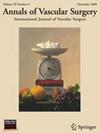对感染性原发性腹主动脉瘤进行血管内和开放式动脉瘤修补术的 10 年回顾性比较。
IF 1.4
4区 医学
Q3 PERIPHERAL VASCULAR DISEASE
引用次数: 0
摘要
背景:本研究比较了感染性原发性腹主动脉瘤(INAAA)患者血管内动脉瘤修补术(EVAR)和开放式动脉瘤修补术(OAR)的疗效,评估了围手术期和院内死亡率、抗生素治疗持续时间、并发症、总生存率和10年无再介入时间:对2004年1月至2019年12月期间确诊的125例INAAA患者(80例EVAR,45例OAR)进行了回顾性队列研究。按照 EVAR-1 和 EVAR-2 试验中制定的指南,根据心脏、呼吸和肾脏状况将患者分为适合或不适合开放手术。主要结果包括 30 天死亡率和院内死亡率。次要结果包括需要再次介入的早期和晚期并发症、抗生素治疗持续时间、10 年总生存率、10 年无再次介入生存率以及影响 30 天死亡率的因素。统计分析采用了卡方检验、t检验和曼-惠特尼U检验。逻辑回归评估死亡率。Kaplan-Meier 估计法评估存活率。结果:OAR 组(37/45,82.2%)和 EVAR 组(62/80,77.5%)均以男性为主(P = 0.693)。OAR 的平均年龄为 64.8 ± 9.8 岁,EVAR 的平均年龄为 69.0 ± 12.6 岁(P = 0.063)。腹主动脉是最常见的动脉瘤位置,占 91/125 例(72.8%)。沙门氏菌属培养阳性病例占 19/45(42.2%),34/125(27.2%)例患者动脉瘤破裂。与OAR(10/45,22.2%;P=0.003)相比,EVAR组中不适合的患者比例更高(41/80,51.2%)。30天死亡率:EVAR为6/80(7.5%),OAR为2/45(4.4%);OR=1.75(95% CI:0.34 - 9.06),P=0.508;院内死亡率:7/80(8.8%),5/45(11.1%);OR=0.77(95% CI:0.23 - 2.58),P=0.668。在抗生素治疗持续时间(中位 11 个月 vs 6 个月,P=0.594)、10 年总生存率(62.8% vs 64.8%,P=0.90)或无再干预时间(83.8% vs 82.不适合患者状态是30天死亡率的独立预测因素(调整后OR,10.654;95% CI,1.041-109.030;P=0.046):我们的研究表明,在INAAA治疗中,EVAR和OAR的治疗效果相当,尽管EVAR更多地在不适合的患者中实施。两种方法的早期死亡率、抗生素治疗持续时间和长期存活率相似,支持EVAR作为OAR的可行替代方案。重要的是,我们发现不适合的患者状态可独立预测围手术期死亡率,这强调了患者选择在治疗决策中的关键作用。这些结果共同表明,EVAR 对不适合 OAR 的高风险 INAAA 患者特别有益,有可能扩大这种具有挑战性疾病的治疗选择。本文章由计算机程序翻译,如有差异,请以英文原文为准。
A 10-Year Retrospective Comparison of Endovascular and Open Aneurysm Repair for Infective Native Abdominal Aortic Aneurysm
Background
This study compared outcomes of endovascular (EVAR) and open aneurysm repair (OAR) in patients with infective native abdominal aortic aneurysms (INAAAs), evaluating perioperative and in-hospital mortality, antibiotic treatment duration, complications, overall survival rates, and reintervention-free times at 10 years.
Methods
A retrospective cohort study of 125 INAAA patients (80 EVAR, 45 OAR) diagnosed between January 2004 and December 2019 was conducted. Patients were categorized as fit or unfit for open surgery based on cardiac, respiratory, and renal status, following the guidelines established in the EVAR-1 and EVAR-2 trials. Primary outcomes included 30-day and in-hospital mortality. Secondary outcomes encompassed early and late complications requiring reintervention, antibiotic treatment duration, 10-year overall survival, 10-year reintervention-free survival, and factors influencing 30-day mortality. Statistical analysis used chi-square, t-tests, and Mann-Whitney U tests. Logistic regression assessed mortality. Kaplan-Meier estimation evaluated survival. Analyses used SPSS version 18.0 (P < 0.05 considered significant)
Results
Males predominated in both OAR (37 of 45, 82.2%) and EVAR (62 of 80, 77.5%) groups (P = 0.693). Mean age was 64.8 ± 9.8 years for OAR and 69.0 ± 12.6 years for EVAR (P = 0.063). The abdominal aorta was the most common aneurysm location, accounting for 91 of 125 (72.8%) cases. Salmonella spp. accounted for 19 of 45 (42.2%) of positive culture cases, and 34 of 125 (27.2%) patients had ruptured aneurysms. The EVAR group had a higher proportion of unfit patients (41 of 80, 51.2%) compared to OAR (10 of 45,22.2%; P = 0.003). Thirty-day mortality rates were 6 of 80 (7.5%) for EVAR and 2 of 45 (4.4%) for OAR; odds ratio (OR) = 1.75 (95% confidence interval (CI): 0.34–9.06), P = 0.508, while in-hospital mortality rates were 7 of 80 (8.8%) and 5 of 45 (11.1%); OR = 0.77 (95% CI: 0.23–2.58), P = 0.668. No significant differences were found in antibiotic treatment duration (median 11 vs. 6 months, P = 0.594), 10-year overall survival rates (62.8% vs. 64.8%, P = 0.90), or reintervention-free time (83.8% vs. 82.2%, P = 0.922), and aneurysm-related death (84.7% vs. 92.9%, P = 0.159). Unfit patient status was an independent predictor of 30-day mortality (adjusted OR, 10.654; 95% CI, 1.041–109.030; P = 0.046).
Conclusions
Our study demonstrates that EVAR and OAR provide comparable outcomes in INAAA management, despite EVAR being performed more frequently in unfit patients. The similar early mortality rates, antibiotic treatment durations, and long-term survival between the 2 approaches support EVAR as a viable alternative to OAR. Importantly, our finding that unfit patient status independently predicts perioperative mortality emphasizes the critical role of patient selection in treatment decisions. These results collectively suggest that EVAR may be particularly beneficial for high-risk INAAA patients unsuitable for OAR, potentially expanding treatment options for this challenging condition.
求助全文
通过发布文献求助,成功后即可免费获取论文全文。
去求助
来源期刊
CiteScore
3.00
自引率
13.30%
发文量
603
审稿时长
50 days
期刊介绍:
Annals of Vascular Surgery, published eight times a year, invites original manuscripts reporting clinical and experimental work in vascular surgery for peer review. Articles may be submitted for the following sections of the journal:
Clinical Research (reports of clinical series, new drug or medical device trials)
Basic Science Research (new investigations, experimental work)
Case Reports (reports on a limited series of patients)
General Reviews (scholarly review of the existing literature on a relevant topic)
Developments in Endovascular and Endoscopic Surgery
Selected Techniques (technical maneuvers)
Historical Notes (interesting vignettes from the early days of vascular surgery)
Editorials/Correspondence

 求助内容:
求助内容: 应助结果提醒方式:
应助结果提醒方式:


